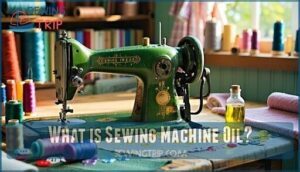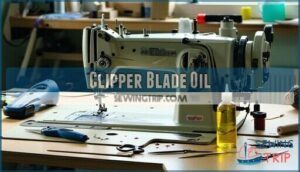This site is supported by our readers. We may earn a commission, at no cost to you, if you purchase through links.

This specialized oil won’t gum up your machine or attract lint like household alternatives.
If you’re caught without proper oil, mineral oil or clock oil work in a pinch.
However, avoid WD-40, 3-in-1 oil, baby oil, or cooking oils—they’ll turn your smooth-running machine into a sticky nightmare.
The wrong oil can cause thread jams, skipped stitches, and expensive repairs.
Your machine’s intricate timing depends on the right viscosity and purity that only proper sewing machine oil provides.
Table Of Contents
- Key Takeaways
- What Kind of Oil Do You Use on a Sewing Machine
- Does Every Sewing Machine Need Oiling?
- What is Sewing Machine Oil?
- Acceptable Sewing Machine Oil Substitutes
- Unacceptable Sewing Machine Oil Substitutes
- Qualities of Acceptable Substitutes
- Reasons for Avoiding Unacceptable Substitutes
- Importance of Genuine Sewing Machine Oil
- Where to Buy Sewing Machine Oil?
- How to Oil a Sewing Machine?
- Frequently Asked Questions (FAQs)
- Conclusion
Key Takeaways
Based on the content about sewing machine oil, here are 4 key takeaways:
- You need genuine sewing machine oil – Use clear, lightweight mineral oil specifically formulated for delicate mechanisms to keep your machine running smoothly without attracting lint or gumming up parts.
- Safe alternatives exist when you’re in a pinch – Tri-Flow oil, pure white mineral oil, clock oil, or clipper blade oil work temporarily as substitutes since they share similar viscosity properties.
- Avoid household oils that’ll damage your machine – Never use WD-40, 3-in-1 oil, baby oil, cooking oils, or lamp oil as they create sticky residues, attract debris, and can cause expensive repairs.
- You’ll save money with proper maintenance – Using the right oil prevents costly breakdowns, extends your machine’s life, and keeps it stitching consistently without skipped stitches or thread jams.
What Kind of Oil Do You Use on a Sewing Machine
Using the right sewing machine oil keeps your machine humming like a well-tuned engine. You need specialized sewing machine lubricant – a highly refined, crystal-clear mineral oil engineered for delicate mechanical parts.
Crystal-clear mineral oil: the lifeblood of every precision sewing machine.
Oil viscosity matters tremendously. Proper sewing machine oil types flow smoothly without gumming up your machine’s intricate components. Think lightweight and clean, not thick like motor oil.
Synthetic alternatives exist but stick with proven petrochemical-based options for reliability. Popular brand comparison shows Dritz, Singer, and Schmetz deliver consistent performance without breaking your budget.
Oil storage in cool, dark places extends shelf life to five years. Oiling frequency depends on usage – typically after every 8-10 hours of stitching.
Skip household substitutes like cooking oil or WD-40. They’ll turn your precision instrument into a sticky mess. Proper sewing machine maintenance starts with the right lubricant choice.
Does Every Sewing Machine Need Oiling?
Not all sewing machines require oiling, but understanding your machine’s needs prevents costly repairs down the road. Modern machines often feature self-lubricating parts and sealed mechanisms that need minimal sewing machine maintenance.
However, vintage models built before the 1950s require consistent sewing machine lubrication to function properly. Check your manual first—some newer machines are oil-free or only need oil for sewing in specific areas like the hook.
For machines requiring regular servicing, oil frequency matters: lubricate after every 3-4 bobbin changes or 8-10 hours of use. Machine maintenance works like car care—skip lubrication tips with older machines, and you’ll hear grinding noises or face mechanical breakdowns.
Sewing machine care isn’t one-size-fits-all. Industrial and marine machines need daily attention, while home machines follow manufacturer guidelines. The key is matching your sewing machine oil routine to your machine’s age and design.
What is Sewing Machine Oil?
Proper machine lubrication keeps your sewing machine running like clockwork. Sewing machine oil is specially formulated lightweight lubricant that reduces friction between moving parts, preventing costly wear and damage.
You’ll find three main oil types: mineral (petroleum-based industry standard), synthetic (lab-created for enhanced performance), and natural (plant-derived but less durable). Machine lubricant viscosity matters – thicker oils can gum up mechanisms while thin oils provide smooth operation.
Quality sewing oil types are clear, odorless, and non-staining. They’re designed specifically for delicate machine performance needs, unlike household alternatives that can damage components. Store properly for five-year shelf life.
For ideal results, using the right sewing machine oil is essential for maintaining your device.
Acceptable Sewing Machine Oil Substitutes
When you can’t find proper sewing machine oil, several alternatives work safely without damaging your machine’s delicate components.
Safe alternatives won’t harm delicate parts—choose wisely when genuine oil isn’t available.
These alternatives, which share similar properties to genuine sewing machine oil, are lightweight and non-sticky, and won’t leave harmful residues on your fabric or internal mechanisms.
Tri-Flow Oil
When searching for premium sewing machine lubricant alternatives, TriFlow oil delivers exceptional sewing performance through its PTFE-enhanced formula.
This sewing machine oil substitute offers superior oil viscosity and machine maintenance benefits:
- Deep penetration reaches tight mechanical components other lubricants miss
- Long-lasting lubrication protection reduces friction and component wear substantially
- Dust-resistant properties maintain cleaner internal mechanisms longer
Tri Flow benefits include excellent machine upkeep capabilities and reliable sewing machine maintenance performance.
The sewing machine also requires regular application of extreme condition lubricants to guarantee smooth operation.
Mineral Oil
Mineral oil stands as petroleum’s gift to your sewing machine. This colorless, odorless lubricant matches your machine’s viscosity needs perfectly.
| Mineral Benefits | Key Features |
|---|---|
| Petrochemical Base | Refined petroleum origin |
| Oil Viscosity | Light, non-gumming formula |
| Refining Process | Multiple purification stages |
| Storage Tips | Cool, dark locations preferred |
White mineral oil flows smoothly through metal components, preventing rust while maintaining peak performance. Its sewing lubricant properties make it an excellent oil for sewing when genuine sewing machine oil isn’t available.
Regular maintenance requires checking the oil lubrication guide to guarantee the longevity of your sewing machine.
Clock Oil
Clock oil serves as an excellent substitute when sewing machine oil runs out.
This refined petroleum product offers proper oil viscosity for smooth machine lubrication without leaving detergent residues.
Clock maintenance formulas protect metal preservation and provide gear protection for mechanical components.
Choose light-viscosity clock oil matching standard sewing lubricant specifications.
While more expensive than regular oil for sewing, it delivers reliable performance for sewing machine maintenance when genuine options aren’t available.
The quality of clock oil products can be researched through Clock Oil to find the best option for your needs.
Clipper Blade Oil
Your hair clippers’ clipper blade oil works surprisingly well as sewing machine oil substitute.
Both share mineral-based formulas with similar oil viscosity, making clipper oil effective for metal protection in sewing machines.
Apply sparingly to metal-on-metal contact points where friction occurs. This blade lubricant prevents wear while maintaining smooth operation.
Though slightly thinner than dedicated sewing machine oil, it provides adequate lubrication for routine sewing maintenance and sewing machine care when proper oil isn’t available.
Regular maintenance involves understanding oil viscosity needs to guarantee the sewing machine runs smoothly and efficiently.
Unacceptable Sewing Machine Oil Substitutes
While it might seem practical to grab any household oil for your sewing machine, using the wrong lubricant can cause serious damage and expensive repairs.
Certain common oils create sticky residues, attract lint, or contain additives that harm delicate machine components.
3. in-1 Multipurpose Lubricant
Despite seeming convenient, 3-in-1 multipurpose oil creates serious problems for your sewing machine. Its thick viscosity and additives cause sluggish operation and residue buildup that clogs delicate mechanisms.
Lubricant Risks with 3-in-1 oil include:
- Sticky residue that attracts lint and debris
- Paint damage from harsh chemical formulation
- Complete machine stoppage from internal clogs
Choosing the right multipurpose lubricant options is essential for maintaining your sewing machine. Choose proper sewing machine oil for reliable lubrication.
WD-40
Never use WD-40 on your sewing machine – it’s a solvent, not a lubricant.
While it initially penetrates well, WD-40 strips away existing lubrication and evaporates quickly, leaving metal parts dry and vulnerable to wear.
| WD-40 vs Sewing Machine Oil | Result |
|---|---|
| Chemical Reactions | Strips existing lubrication |
| Machine Damage | Attracts moisture, promotes corrosion |
| Spray Lubricants Performance | Evaporates, leaving parts unprotected |
Professional repair guides consistently warn against WD-40 for sewing machine maintenance.
Choose proper sewing machine oil for reliable lubrication instead.
Baby Oil
While WD-40 strips away lubrication, baby oil presents different but equally serious Baby Oil Risks for your sewing machine. This fragrant mineral oil wasn’t designed for Machine Maintenance—its viscosity causes sticky buildup that jams delicate mechanisms.
Baby oil’s composition includes additives that can degrade internal components over time. The oil penetrates fabric too readily, lacking the proper consistency needed for sustained lubrication in sewing machine upkeep. You’ll find it attracts dust and debris, creating costly cleaning challenges.
Professional repair technicians consistently warn against using baby oil as an oil for sewing alternative. The fragrance chemicals can disrupt ideal lubrication, while the improper viscosity leads to residue accumulation. Stick to genuine sewing machine oil for reliable Sewing Machine Care—your machine’s longevity depends on proper Lubrication Tips.
Unacceptable Substitute Reason
Lamp Oil (Paraffin)
Lamp oil (paraffin) poses serious paraffin risks to your sewing machine despite seeming like a reasonable oil alternative. This highly refined kerosene lacks proper formulation for machine maintenance and sewing machine care.
Here’s why paraffin threatens your equipment:
- Creates sticky residue that attracts dust and lint accumulation
- Contains harmful additives that can corrode metal components over time
- Evaporates quickly, leaving gummy deposits that disrupt mechanisms
Unlike proper sewing machine oil, lamp oil compromises fabric protection and machine longevity. Stick with dedicated mineral oil formulations designed for precision machinery.
Olive Oil
You might think olive oil’s a natural choice since it’s sitting right in your kitchen cabinet.
Olive oil turns rancid over time, creating sticky deposits that attract lint and dust.
This gums up your machine’s moving parts and can harden into damaging residue.
These Oil Alternatives pose Sewing Machine Damage risks through Lubrication Mistakes.
Proper Machine Maintenance requires avoiding natural oils like olive oil in favor of specialized sewing machine oil or approved synthetic oils.
Qualities of Acceptable Substitutes
Choosing the right substitute for sewing machine oil isn’t guesswork—it’s about understanding what your machine needs.
While unacceptable oils can damage your equipment, quality substitutes share specific characteristics that make them safe alternatives.
The best sewing machine oil substitutes possess these critical qualities:
- Low oil viscosity that flows smoothly through tight mechanical spaces
- Chemical compatibility with plastic, rubber, and metal components
- High purity from advanced refining processes that eliminate harmful additives
- Long-term stability that resists oxidation and gumming over time.
Synthetic oils and white mineral oil excel because their mineral properties match genuine sewing machine oil characteristics.
These lubricant types undergo similar refining processes, ensuring they won’t react with your machine’s materials or leave residue buildup.
Think of acceptable substitutes as precision instruments themselves—they’re engineered for delicate mechanical systems.
Whether you’re using Tri-Flow, mineral oil, or clock oil, each maintains the exact oil viscosity and synthetic sewing machine oil compatibility your machine requires for smooth operation.
Reasons for Avoiding Unacceptable Substitutes
Using unsuitable oil substitutes can seriously harm your sewing machine’s performance and longevity. Understanding why certain oils cause problems helps you make better maintenance choices and avoid expensive repairs.
Residue Build-Up
When you use unsuitable oils on your sewing machine, residue buildup becomes your worst enemy.
Household oils like 3-in-1 and WD-40 create sticky deposits that attract lint accumulation and cause machine clogging.
These gummy residues mix with dust, forming clogs that freeze moving parts.
Oil contamination from cooking oils creates glue-like substances, while improper lubrication leads to fabric staining.
Part corrosion accelerates when wrong oils leave brown films on metal components.
Choose residue-free sewing machine oil for proper oil application instead.
Mechanism Disruption
Poor oil viscosity creates friction issues that freeze your machine’s mechanisms. Incorrect lubricants cause wear prevention failure, leading to sluggish performance and skipped stitches.
Machine failure occurs when penetrating oils evaporate under heat, leaving parts unprotected. Following proper lubrication tips with genuine sewing machine oil prevents mechanism disruption and costly repairs.
Regular maintenance, including understanding common sewing mistakes, is essential for extending the life of your sewing machine and preventing costly repairs. Proper care with the right lubrication tips can significantly impact the longevity and performance of your machine.
Costly Repairs Risk
Wrong oil can drain your wallet fast.
Repair costs range from $75-$100 per tune-up when oil contamination occurs.
Machine failure from maintenance neglect leads to expensive part replacements.
Improper sewing machine oil creates sticky residues requiring professional cleaning and mechanical repairs.
Sewing machine repair bills quickly exceed proper sewing machine oil costs.
Smart lubrication prevents costly breakdowns.
Potential Part Damage
Improperly lubricating your sewing machine frequently causes serious mechanism damage that extends far beyond surface issues.
Oil contamination from household substitutes creates residue buildup that corrodes delicate metal components, leading to part failure.
Machine wear accelerates when wrong oils harden internal mechanisms, causing expensive metal corrosion.
Proper machine maintenance with genuine sewing machine oil prevents costly sewing machine part damage and keeps your investment running smoothly.
Importance of Genuine Sewing Machine Oil
Genuine sewing machine oil stands as the cornerstone of proper machine maintenance, delivering unmatched reliability for your valuable equipment.
Quality lubricants protect your investment while guaranteeing consistent Sewing Performance over years of use.
Here are five key Oil Benefits that make authentic sewing machine oil essential:
- Machine Longevity – Proper lubrication prevents premature wear on moving parts
- Reduced Maintenance Costs – Quality oils minimize expensive repair bills
- Consistent performance – Genuine oils maintain smooth operation without gumming
- Warranty protection – Using recommended oils keeps your coverage intact
- Peace of mind – Trusted formulations eliminate guesswork in sewing machine maintenance
Unlike synthetic sewing machine oil alternatives or household substitutes, genuine products undergo rigorous testing to meet manufacturer specifications.
These specialized lubricants resist oxidation, maintain proper viscosity, and won’t contaminate your fabric or thread.
Following proper Lubrication Tips with authentic oil guarantees your machine runs quietly and efficiently, making every stitch count.
Where to Buy Sewing Machine Oil?
Your sewing machine’s oil requirements don’t have to create shopping stress. Finding quality lubricants is easier than you think with these reliable options:
- Online Retailers: Amazon and specialty sewing websites offer extensive oil brands like Dritz and Singer, delivered to your doorstep.
- Sewing Stores: Local fabric shops and dedicated sewing machine oil stores provide expert guidance on compatible lubricants.
- Department Stores: Walmart and Target stock basic sewing machine oil in their craft sections.
- Local Suppliers: Hardware stores and sewing machine oil retailers often carry specialty lubricants for vintage machines.
Browse sewing machine oil online for convenience, or visit local shops for personalized recommendations that match your machine’s specific needs. Regular use of sewing machine oil is essential for maintaining smooth operation and preventing damage.
How to Oil a Sewing Machine?
Proper machine maintenance begins with preparation—unplug your sewing machine and remove accumulated lint and debris.
This cleaning step prevents contamination that could harm your machine’s performance.
Follow these essential lubrication tips for effective oil application:
- Apply only one small drop at each designated oiling point
- Target moving metal parts like the needle bar and bobbin area
- Test on scrap fabric after oiling to absorb excess oil
Your sewing machine care routine should include regular maintenance checks.
Consult your manual to identify specific oiling locations, as over-lubrication can stain fabric and attract more lint.
Most machines require oiling every 8-10 hours of use, though oiling frequency varies based on your sewing habits.
Store sewing machine oil in a cool, dark place to maintain its effectiveness for superior oil for sewing performance.
Regular sewing machine maintenance is vital to extend the lifespan of your machine and guarantee smooth operation.
Frequently Asked Questions (FAQs)
What type of Oil can you use on a sewing machine?
Like a well-oiled machine runs smoothly, you’ll need specialized sewing machine oil—lightweight mineral oil that’s colorless and non-staining.
Use brands like Singer, Dritz, or white mineral oil for superior performance.
Which lubricant is best for a sewing machine?
Use specialized sewing machine oil—it’s lightweight, non-staining mineral oil designed for delicate parts.
Brands like Singer, Dritz, or Schmetz work perfectly.
Avoid WD-40, 3-in-1, or cooking oils that’ll gum up your machine, as they are not designed for this purpose.
How to use sewing oil?
Carefully clean your machine first, then apply single drops of specialized sewing machine oil to designated points like the needle bar, bobbin area, and moving parts.
Run the machine briefly to distribute oil evenly throughout.
What type of oil should you avoid using in a sewing machine?
Avoid WD-40, 3-in-1 oil, automotive lubricants, cooking oils, and baby oil. These create sticky residues, attract lint, damage components, and can stain fabric permanently.
Can you use natural oils on a sewing machine?
Natural oils aren’t recommended for sewing machines. They’re less effective than petrochemical oils and can gum up your machine if not properly mixed with additives, potentially causing long-term damage.
Should you use lubricating oil on a sewing machine?
Yes, you should absolutely use lubricating oil on your sewing machine – but not just any lubricant will do.
Think of it as your machine’s lifeblood; proper sewing machine oil keeps metal parts gliding smoothly, prevents costly wear, and extends your machine’s life substantially.
Which oil is best for a sewing machine?
High-quality sewing machine oil is best—use specialized mineral oil from brands like Singer, Dritz, or Schmetz.
You’ll want lightweight, clear, non-staining oil that won’t gum up your machine’s delicate parts over time.
Can I use any oil for my sewing machine?
No, you can’t use just any oil for your sewing machine.
Using incorrect oils like WD-40, cooking oil, or 3-in-1 lubricant will damage internal components and void your warranty.
Only use specialized sewing machine oil.
What oil is similar to sewing machine oil?
Looking for alternatives when you’re out of specialized sewing machine oil?
Tri-Flow oil, pure white mineral oil, and other substitutes like clock oil, and clipper blade oil work well.
These petroleum-based substitutes provide proper viscosity and lubrication without gumming up your machine’s delicate parts.
Which oil can be used as machine oil?
Standard sewing machine oil, mineral oil, Tri-Flow oil, clock oil, and clipper blade oil work as machine lubricants.
You’ll want lightweight, non-detergent options that won’t gum up moving parts or leave sticky residues behind, using non-detergent choices to maintain your machine’s performance.
Conclusion
Picture your sewing machine humming smoothly through delicate silk, its parts gliding like a well-choreographed dance.
This performance depends entirely on what kind of oil you use on a sewing machine. Genuine sewing machine oil remains your best choice—it’s specially formulated to keep mechanisms running without attracting lint or gumming up parts.
While mineral oil or clock oil work temporarily, avoid household alternatives that’ll create costly problems.
Regular maintenance with proper oil protects your investment and guarantees consistent stitching performance for years ahead.
- https://leatherworker.net/forum/topic/86079-sewing-machine-oils/
- https://www.reddit.com/r/vintagesewing/comments/1df9rch/what_is_the_best_oil_for_sewing_machines/
- https://www.woodworkingtalk.com/threads/which-is-the-lighter-oil-sewing-machine-or-gun-oil.233353/
- https://www.goldstartool.com/blog/the-best-oils-and-lubricants-for-your-sewing-machine.htm
- https://www.youtube.com/watch?v=6zMjvctYrKQ

















